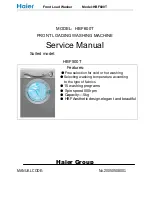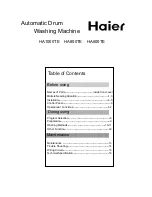
2
3. INSTALLATION
3.1. Unpacking
Packing used to protect internal parts of the washing
machine during transport must be removed before the
washing machine is put into service for the first time.
Remove all packing from the
washing machine. Tilt the washing
machine sideways and then remove
the packing under the motor, and
straighten the washing machine.
Tilt the washing machine back-
wards, rotate it by a quarter of a turn
on one of its corner to remove the
transport base.
Open the washing machine lid and
remove the immobilization packing
and plastic films.
Close the lid.
Use a 10 mm spanner to remove the
two screws and spacers at the back.
You can now see the openings that
must be closed with the caches in the
pack attached to the washing machi-
ne; do not forget to fold down the
central capsule.
Make sure that you have removed all
these parts from your washing ma-
chine and keep them so that you can
use them again if you need them for
future transport.
If you want to keep your washing ma-
chine aligned with the adjacent furni-
ture, you can cut the pipe support
strip at the back of your washing ma-
chine. Leave the two side closers in
place.
3.2. Position
Put the washing machine on a flat hard floor in a well venti-
lated room.
Make sure that your washing machine does not touch the
wall or any other furniture in the room.
3.3. Moving your washing machine
If you want to move your washing
machine, lift it onto its rollers by pul-
ling the lever at the bottom of the
washing machine all the way to the
left. When you have put your
washing machine into the required
location, put the lever back into its
initial position.
3.4. Leveling
Precise leveling will prevent vibrations, noise and move-
ments of the washing machine during operation.
Make the washing machine level by
adjusting the leveling screw that is
too short.
Unscrew the stand and locking col-
lar assembly (lift the washing machi-
ne if necessary).
When the washing machine is sta-
ble, maintain the stand on the
ground and turn the locking collar as
far as posible.
3.5. Water inlet
Screw the supply ppe con-nector
onto the water inlet tap (20x27
mm), remembering to use the
washer provided with the washing
machine.
Open the water inlet tap.
You cannot prolong the water inlet
pipe. If it is too short, buy a longer
pipe provided for this purpose.
3.6. Drain
The drain siphon must be placed
inside a drain pipe (or in a washba-
sin) at a height of between 70 and
100 cm. Make sure that it cannot
fall.
•Important: the drain pipe must
never be prolonged. If it is too
short, call a professional.
3.7. Electrical connection
You can only connect this washing machine to 230 V single
phase power supply.
Check rating of the fuse line: 10 A at 230V.
The washing machine must not be connected through an
extension cable or a power bar.
Check that the earthing connection is conform with the regu-
lations in force.


























